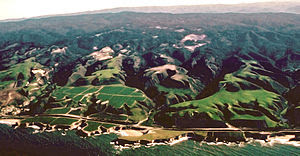Typical sequence of erosional marine terrace;
1.Low tide cliff
2.Modern shore platform
3.Inner edge
4.Modern sea cliff
5.Old shore platform
6.Paleo shorelineangle
7.Paleo sea cliff
8.Terrace cover deposits
9.Alluvial fan
10.Decaved and covered sea cliff & shore platform
11.Paleo Sea level I
12.Paleo Sea level II
- A rock terrace formed a sea cliff, with a wave- cut platform before it, is raised above sea level.
examples ;
California
Oregon
Chile
Gibralta
New Zealand
Other islands of the Pacific
 |
| lowest marine terrace at Tongue Point, New Zealand |
- A marine terrace called as coastal terrace.
- Raised beach or perched coastline is relatively flat.
- Horizontal or gently inclined surface of marine origin.
- It is bounded by;
-a steeper ascending slope on the landward side.
-a steeper descending slope on the seaward side
 |
| marine terrace ,Santa Maria Island, south-central Chile. |
- The platform gradient between 1°- 5°.
- The width is reaching up to 1000 m.
- It seems to differ between northern and southern hemisphere.
- Sub-horizontal platforms usually terminate in a low tide cliff.
- Marine terraces extend for several tens of kilometers parallel to the coast.
- Older terraces are covered by marine / alluvial materials.
- Marine terraces can be covered by a wide variety of soils.
- In protected areas allochtonous sandy parent materials from tsunami deposits may be found.
- Common soil types found on marine terraces include planosols and solonetz.
 |
| marine terraced ,north of Santa Cruz, California |
 |
| marine terraces at Tongue Point, New Zealand |



No comments:
Post a Comment